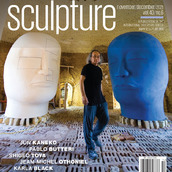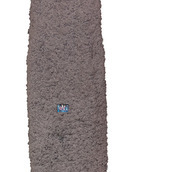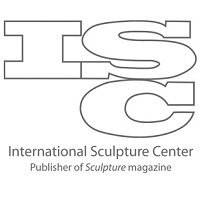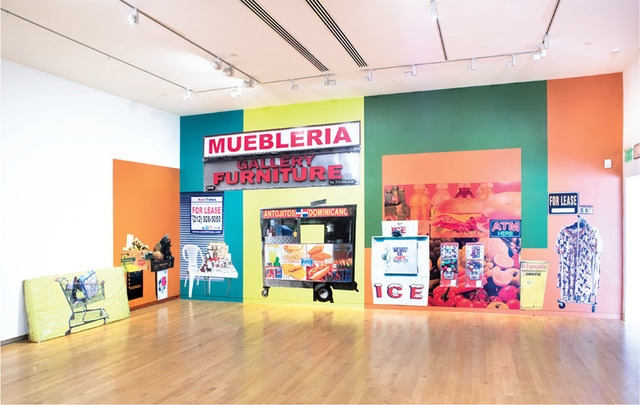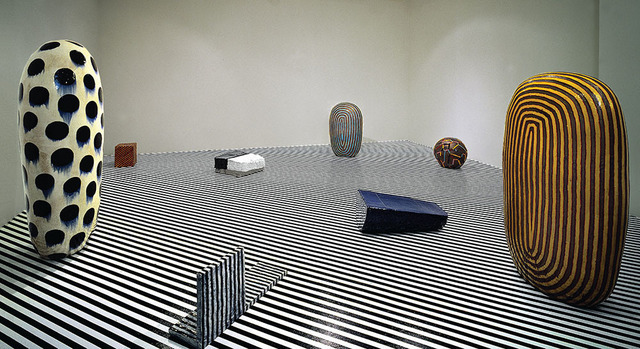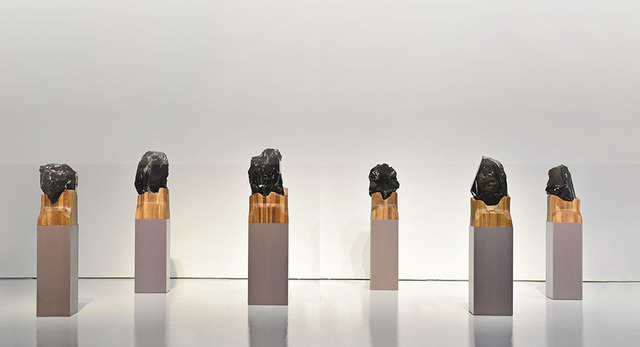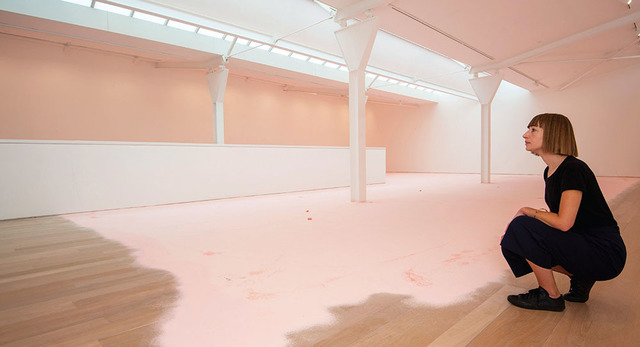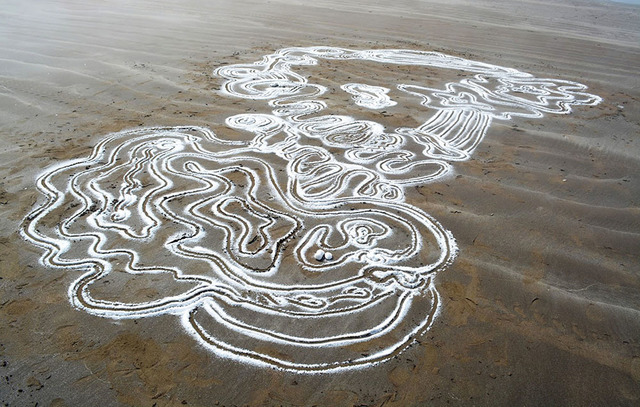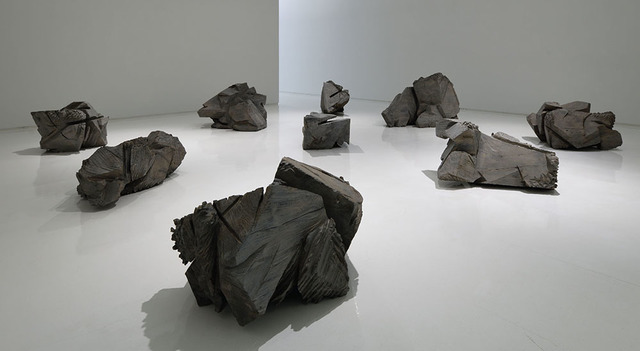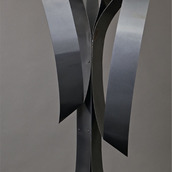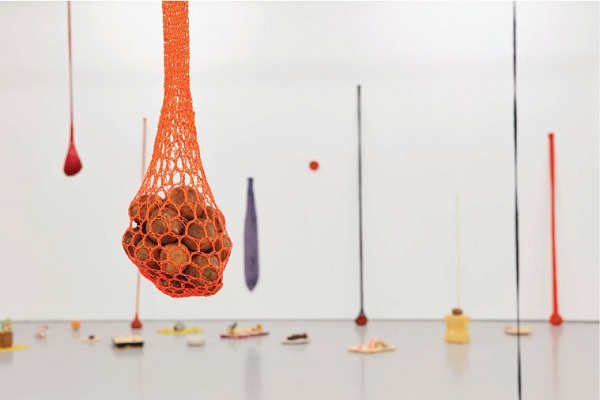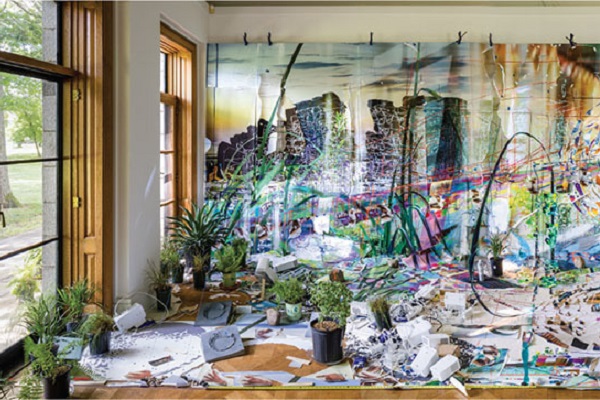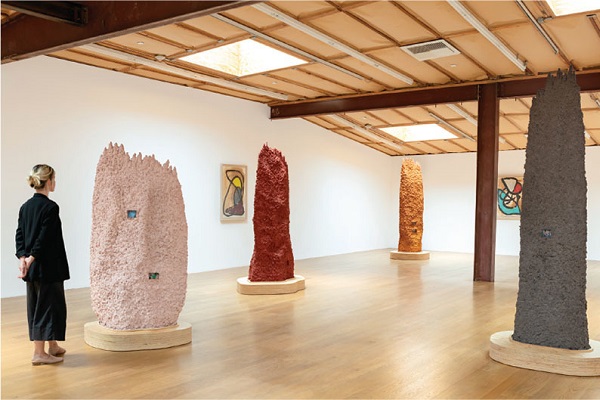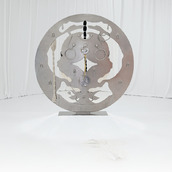Review: Sarah Sze

Viewable Image - fifth season
Image Caption
Sarah Sze, Fifth Season , 2021. Mixed media, oil paint, acrylic paint, ink, canvas, projectors, plants, clay, archival paper, aluminum, plastic, wood, water, lights, fan, string, video, photographs, dirt, metal mirrors, and stones, detail of installation. Photo: Nicholas Knight, Courtesy the artist and Sarah Sze Studio.MOUNTAINVILLE, NEW YORK
Storm King Art Center
Sarah Sze’s Fallen Sky—Storm King’s first permanent commissioned outdoor sculpture since Maya Lin installed Storm King Wavefield in 2008—resembles a silhouetted planet earth, as if photographed from space. Composed of 130 polished steel fragments nestled into native grasses, it occupies the site where a large tree once stood. The fairly intact curving crescent lifting up from the ground contrasts with the more broken-up curvature below to suggest entropy: the "fallen sky" is disappearing into the earth, subject to the elements, new growth, and changing seasons.

Viewable Image - fifth season
Image Caption
Sarah Sze, Fallen Sky , 2021. Stainless steel, 36 ft. diameter. Photo: Nicholas Knight, Courtesy the artist and Sarah Sze Studio.Fifth Season, Sze’s indoor installation created for Storm King’s main gallery (on view through November 8, 2021), picks up on this theme, proposing a new season, born of imagination. The composition flows in many directions, physically and conceptually, suggesting city and country, the natural and built worlds, the pandemic and its aftermath. The 11,000 component pieces start as a wall- and floor-based promenade through a landscape that cascades outward and inward as multiple old-fashioned slide projectors and more up-to-date digital projectors shoot out light, roam across the gallery, move images in loops, replay images of captured light, and reveal shadows outside their frames—literally bringing nature and viewers into a field of static and moving elements.
The multisensory visual feast also reflects on the creative process. It breaks down and lays out materials, tools, and processes applied to the creation of art—box cutters, glue, drawing and painting tools, papers, and canvas line the perimeters of the piece and rove inward—a maximalist approach to planes and volumes that Richard Serra honed at Storm King as a Minimalist (Schunnemunk Fork, 1991). Fifth Season also includes maquettes, drawings, cutouts, and mixed-media works related to Fallen Sky, suggesting some of the ways that Sze meditates on and experiments with a new idea before it is fully realized. Artist Buzz Spector, who has some familiarity with Sze’s process, says, "Sze makes plans in order to discard them. She came here with a clue but not with a script."

Viewable Image - fallen sky
Image Caption
Sarah Sze, Fifth Season , 2021. Mixed media, oil paint, acrylic paint, ink, canvas, projectors, plants, clay, archival paper, aluminum, plastic, wood, water, lights, fan, string, video, photographs, dirt, metal mirrors, and stones, detail of installation. Photo: Nicholas Knight, © Sarah Sze, Courtesy the artist and Sarah Sze Studio.Hands appear in many frames and media, signifying the common human desire to make; one set of hands moving under water is especially intriguing. As viewers circle Fifth Season, gyroscopes of color on the wall and floor reveal what may be the earth, private inner worlds, or outer space. A series of black grids could represent New York City’s shutdown during the pandemic, or they might signal abstract building blocks for an idea. The entire installation offers countless openings into broader thoughts and associations, including how to better understand our own and the planet’s seasons.
If the message of Fifth Season harbors hope and possible renewal, Fallen Sky seems to caution against the effects of climate change and environmental abuse, its fractured circle and crescent symbolism prompting natural, cultural, and spiritual associations. The finished work, reinforced by its earlier iterations in Fifth Season, embodies a concept that is timeless yet unique, beautiful in its rough-edged, broken state—of our time and of the future.
—JAN GARDEN CASTRO
Review: Pia Camil

Viewable Image - installation view
Image Caption
Pia Camil, installation view of "Nidos y Nudos," 2021. Photo: Jenalee Harmon, © Pia Camil, Courtesy the artist, Blum & Poe, Los Angeles/New York/Tokyo.LOS ANGELES
Blum & Poe
Pia Camil’s work has consistently engaged ideas of power, consumerism, and collectivity, using the mass-market waste of Mexico City’s urban landscape to create theoretically complex objects and participatory installations. Her new body of work, produced after she relocated from the city to the rural countryside during the pandemic, takes these themes in a different direction. In her recent exhibition, "Nidos y Nudos," strange, amorphous sculptures and drawings look to the natural world to generate alternative models for relating to and counteracting the isolated, capitalist world that we’ve created.
Scattered through a large gallery, 10 freestanding and individually titled "Nidos" ("Nests," 2021) resembled a field of totemic beings, their forms inspired by Camil’s encounter with labyrinthine termite mounds on the Pacific coast of Mexico. Using an extensive system of tunnels and conduits, millions of tiny insects collectively build climate-controlled mounds that can rise more than five meters above underground nests. Camil’s "Nidos" are constructed from concrete, mortar, and recycled newspaper over steel frames and painted in bright pigments such as turquoise and terra cotta. Their architectural shapes suggest dwellings, designated places of protection and germination.

Viewable Image - concrete recycled
Image Caption
Pia Camil, No School (detail) , 2021. Concrete, recycled newspaper pulp, pigment, found images, steel, and plywood base, 89.5 x 35 x 34 in. overall. Photo: © Pia Camil, Courtesy the artist, Blum & Poe, Los Angeles/New York/Tokyo.Each "Nido" contains small windows, inviting viewers to explore in more detail, but the offered views do not penetrate the interior of the sculptures. Instead, the apertures frame images cut from recycled newspapers and removed from their original context. The subjects range from comic and serene to grim, recalling the cacophony of daily news. In Pietà, a person wearing full-body PPE naps in a metal office chair; VR features a cow wearing a VR headset alongside a Zoom screenshot with users named "peepee," "Pillow Princess," and "JerryfromCheer"; and Inframundo (Underworld) includes images of a field of marigolds, a wall of skulls discovered in an ancient Aztec tower in Mexico City, and a group of people carrying a coffin over a subway turnstile.
The biomorphic forms, textured surfaces, and apertures of the "Nidos" bring to mind the plaster lairs and cocoons that Louise Bourgeois created in 1964 on her return to the art world after an 11-year hiatus. Bourgeois (quoted in Louise Bourgeois, London: Tate Publishing, 2007) described these works as "a thing you build yourself in order to avoid a trap. It is a place where you can be safe. You have built it yourself." Camil’s nests, however, reject self-preservation and retreat to propose a form of communal living and the notion of the hive mind, or a collective networked intelligence. A termite mound is essentially an intelligent sculpture where social interactions influence foraging activities, which in turn modify the form and content of the nest.
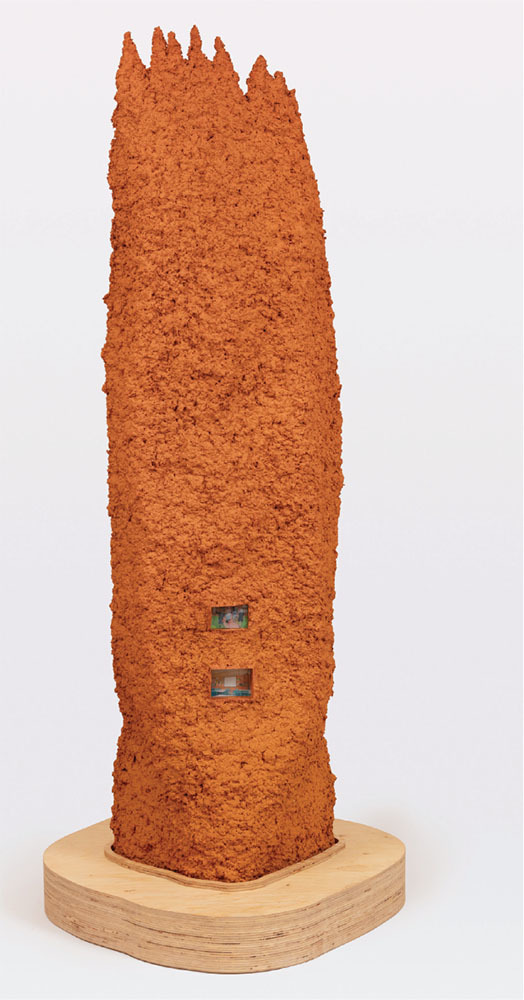
Viewable Image - concrete recycled
Image Caption
Pia Camil, No School, 2021. Concrete, recycled newspaper pulp, pigment, found images, steel, and plywood base, 89.5 x 35 x 34 in. overall. Photo: © Pia Camil, Courtesy the artist, Blum & Poe, Los Angeles/New York/Tokyo.Camil’s "Nudos" ("Knots") drawings expand her reflections on nests by exploring "sympoiesis, or making-with" rather than "autopoiesis, or self-making," concepts taken from Donna Haraway’s 2016 book Staying with the Trouble: Making Kin in the Chthulucene. Camil’s wandering lines of ink, oil stick, and clay mimic the intricate pathways created by insects, the coiling of an umbilical cord, and the knotted and intertwined nature of human and non-human relationships. With the "Nidos" and "Nudos" works, we find an expression of the dilemma between inside and outside, alliance and isolation, vulnerability and aggression, exposing the borders and depths of conflicting, chaotic feelings around the body, home, family, and society at large.
—SALLY EAVES HUGHES

